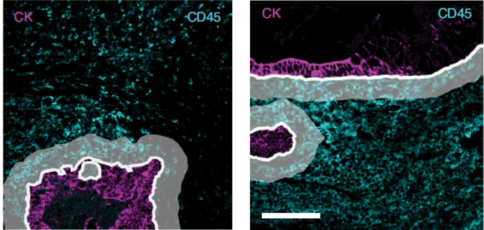
All things that live are composed of cells, whether it be a single-celled organism like a bacterium, or something made of trillions of cells like a human. For beings that are made of trillions of cells, populations of cells are consolidated into organs or tissues, and work together to make the proteins and other biomolecules that are needed to keep that being alive. However, each of those types of cells has a specific role to play in maintaining the life of that being – for example, only B cells will make antibodies, so if a scientist finds a cell that is making antibodies, they can conclude that this cell is a B cell. Because of this, researchers funded by the NIH Common Fund Human BioMolecular Atlas Program (HuBMAP), are generating molecular profiles of proteins which can identify certain kinds of cells, and then use those profiles to predict where the cells are in relationship to each other in healthy and tumor samples.
HuBMAP researchers Drs. Michael Angelo, Sean Bendall, and colleagues at Stanford University developed a computational method called “single-cell metabolic regulome profiling” or scMEP. scMEP measures and identifies the proteins involved in performing the functions of cells, as well as where the cells are in relationship to each other within a sample using computational methods to analyze the proteins found by a technique called mass cytometry. In scMEP, mass cytometry is used to identify cells by attaching heavy metal ions to antibodies. Antibodies are very specialized and thus will only bind to specific proteins made by specific cell types. For this reason, researchers can identify proteins and cell types by designing antibodies to bind to proteins and using imaging methods to see where the attached heavy metal ions are in a sample. Once the researchers know what proteins are made by which type of cells, they can build metabolic profiles of those cell types and give that information to scMEP. scMEP can then use these profiles to predict the identity of unknown cell types in samples from either healthy people or patients with colorectal cancer. Once the unknown cells are identified, researchers can then use imaging methods to see where tumor and immune cells are in relationship to each other in a sample from a person with colorectal cancer.
scMEP allows researchers to identify the type of cell, and what metabolic processes that cell is performing at a specific moment. Because it uses antibody-based methods for identification, scMEP can be incorporated into any protein-based approach. The researchers hope that by incorporating scMEP into clinical workflows, scientists will be able to better predict how patients respond to immunotherapy, or perhaps find new biomarkers to allow earlier diagnoses of disease, or possible therapeutic targets. They believe that scMEP will give researchers a deeper understanding of cellular metabolism, and thus a greater understanding of the processes that affect human disease.
Single-cell metabolic profiling of human cytotoxic T cells. Hartmann FJ, Mrdjen D, McCaffrey E, Glass DR, Greenwald NF, Bharadwaj A, Khair Z, Verberk SGS, Baranski A, Baskar R, Graf W, Van Valen D, Van den Bossche J, Angelo M, Bendall SC. Nat Biotechnol. 2020 Aug 31. doi: 10.1038/s41587-020-0651-8. Online ahead of print. PMID: 3286913
This work is supported by NIH grant # UH3 CA246633-02.


